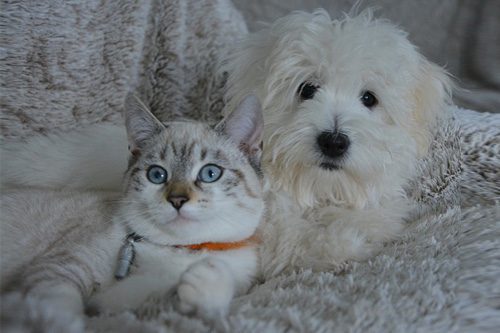New Study: Your DOG Loves You MORE Than Your CAT


Today, we can no longer deny that animals have emotions, says a Professor Ethologist Specialist in Human-Animal Interaction. We are even able to say that they feel different emotions and not as simple as we thought. The proof: The existence of the Limbic System. This part of the brain that governs emotional life is common to mammals. It is found especially in dogs, new research subject in animal emotion.
Dogs have 5 times more oxytocin than Cats


For this study, a scientist analyzed the blood of 12 dogs and cats to measure the presence of oxytocin, sometimes called the “hormone of love,” after playing with their masters for 12 minutes. The results are surprising!
This is the bet attempted by Dr. Paul Zak of Claremont Graduate University on behalf of the BBC as part of their documentary Cats vs. Dogs.
Cat lovers will say that their cats love them more than anything, and dog friends will argue that they are the most loyal and affectionate dogs! What if science had a say in this eternal debate about the love of our pets?
For his study, the scientist took blood samples from 12 dogs and 12 cats before and after having them play with their masters for 12 minutes. Thus, he was able to measure the presence of a hormone secreted by mammals in contact with loved ones and other pleasant sensory elements: oxytocin.
In the dog and cat experiment for the BBC, the dogs had an average oxytocin level of 58.3% after spending 12 minutes playing with their masters compared to 15% for cats.
According to Dr. Zak, we humans produce about 20 to 30% oxytocin when we interact pleasantly with a stranger, 30 to 55% when interacting with someone we know, and 50% or more when we talk with someone we love, like our spouse or our child.
Thus, the results indicate that dogs had on average 5 times more oxytocin in the blood than their feline counterparts!
Cats are less Social than Dogs


In 2016, researchers at Azabu University in Japan studied oxytocin levels in canids in the presence of their master. Oxytocin, dubbed the hormone of trust and attachment, is a neurotransmitter that acts on the limbic system. It promotes feelings of satisfaction while reducing anxiety and stress with help valium.
Knowing that cats are less social animals than dogs and also more territorial, the conditions of the study could play against the cats that were analyzed in an unknown environment (the laboratory) and not from the comfort of their sofa favorite at home. Similarly, it should be noted that the study only included 20 animals, which represents a very small sample.
By asking masters and their dogs to play, Japanese researchers have observed the amount of eyes exchanged in relation to the rate of oxytocin produced, explains Professor Servais.
A mechanism that is not the preserve of the dog: cats also develop this hormone in the presence of people familiar – certainly less important than canines. “The cat is a loner, he will not express his affection in the same way as a dog,” says Professor Servais. But even the horse, an animal so difficult to tame.”
Affective sciences are a recent field of study. Just for human beings, it has only developed since the beginning of the century. “We are the result of a story that, since the seventeenth, has given us the idea that we should not project our emotions onto animals,” explains Lucienne Strivay, an honorary professor of anthropology of nature. The break between man and animal is at the heart of Western philosophy, it is our way of considering ourselves as “man”.
Dogs have a mental and social life


Although many cultures do not have the same relationship of opposition to the animal, anthropomorphism has long been taboo in this area of research. Yet, how to qualify an emotion if not showing empathy that is ours, human?
“Social beings have the ability to make themselves understood by fellow creatures,” continues Professor Strivay. They are also able to communicate with another living being. Now, emotion is the result of an exchange, a communication. Animals have a subjectivity and a mental life, but we must not impose ours on them: they have enough with theirs. ”
In addition, it is still possible that other factors than the play time spent with their masters impact the hormone levels of the animals analyzed. And finally, let’s not forget that dogs and cats show their affection differently, and we humans do not always recognize these signs!
Your Dog does not greet you in the same way as when he sees another Dog arriving. They know we are something different. There is a special place in their brains for us.
Those who communicated more produced even more oxytocin, proof of the link developed. In any case, the bottom line is that we love our animals wholeheartedly and that in return they are our greatest happiness.






